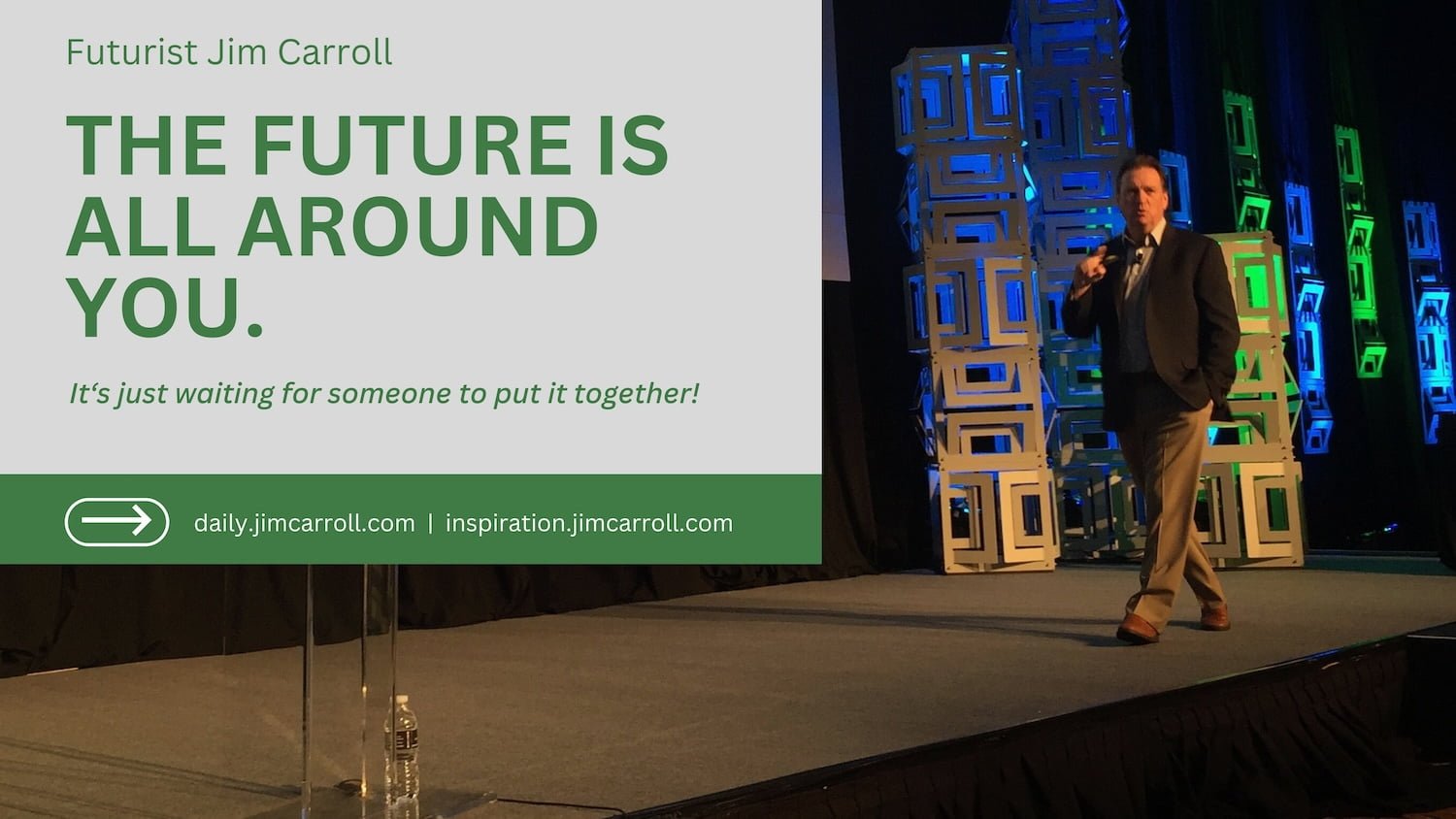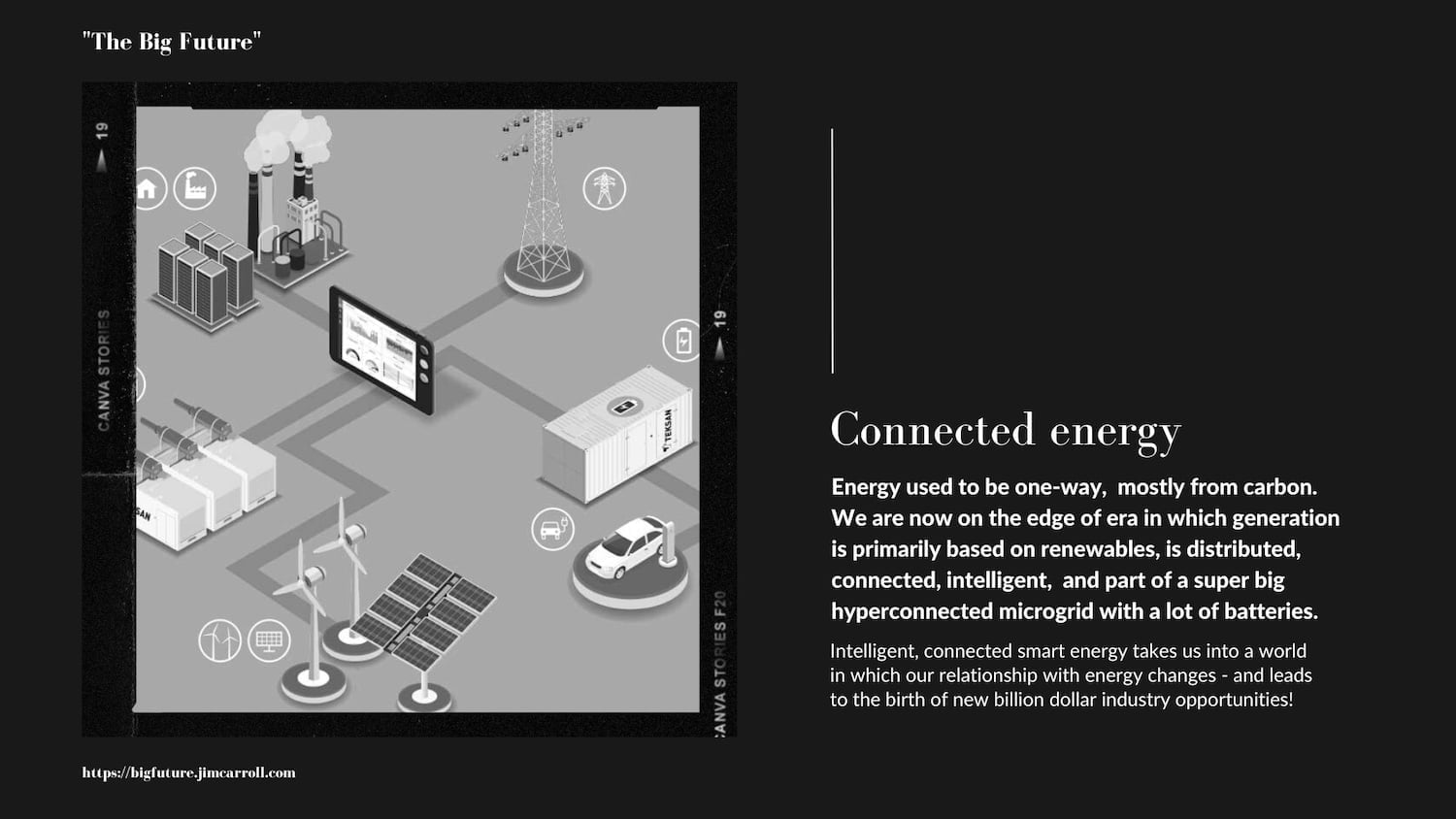“The future is all around you. It’s just waiting for someone to put it together!” – Futurist Jim Carroll

We are on the edge of massive multi-billion business opportunities in many industries, only awaiting someone to put the parts together that will fully exploit the major trends already in existence (or evolving rapidly.)
That’s a story I often carry onto stage with me, as I outline how many aspects of the future already exist, and are only awaiting the ‘oackacking’ of those trends into one neat, tidy disruptive initiative.
Take the world of construction and energy. It’s a given that over the long term, most homes will be powered by solar power or wind power, with natural gas or other carbon energy sources merely acting as an ‘insurance policy;’ for times of variability. Battery storage technology will be at the heart of the technology setup that makes this crazy economical – storage costs have declined 97% in the last three decades, and continue to plummet. The home will contain some large massive energy storage battery – and your future car will also be a part of your home energy system. Pulling it all together will be the next evolution of your home thermostat such as your Nest or ecoBee – running some sophisticated software algorithm that will keep it all running, in sync, maximizing energy production.
Some companies are working to do this already today – keep your eye on the Tesla Powerall system, but also closely watch what Generac is up to – there was a reason they bought ecoBee.
The key thing with this trend is that solar power won’t just come from the solar on the roof – it will come from the very windows that are part of the home, as glass evolves to become a form of solar power generation. These windows will automatically darken with excessive external sunlight, to help cool the home. They look like regular glass windows, but act like solar panels, generating electricity from the sun. The cost to manufacture these new see-through window panes will start to plummet in the same way that other solar technology has – in other words, they will become dirt cheap, and to pardon the use of a phrase, as common as nails.
The opportunity is huge – right now, there are almost seven billion square meters of glass surfaces to be found in windows. Imagine that the glass in most new commercial, industrial, and residential construction is made of transparent solar panels. Imagine a massive retrofit of such technology given the cost path they are likely to follow. Transparent solar panels look like clear glass and let light through like regular windows. One estimate suggests solar windows and related transparent solar technologies could provide around 40% of energy demand in the United States. That’s a pretty big number.
Put these trends together, and you get a pretty significant hyper-trend that I call “Connected Energy,” which I wrote about in my Big Future series:
Bottom line: energy in our electrical system used to be one-way and was mostly from carbon. We are now on the edge of an era in which it is becoming a two-way system, with generation primarily based on renewables, distributed, connected, intelligent, and part of a super big hyperconnected microgrid with a lot of batteries. And AI plays a huge role already and an even bigger role in this new energy grid going forward.
For lack of a better term, I called it intelligent, connected smart energy, and it takes us into a world in which our relationship with energy changes – and leads to the birth of new billion-dollar industry opportunities!

What’s happening?
Essentially, we are building a new energy grid, launching new industries, changing entire mobility platforms (automotive and trucking), and setting a path to a cleaner energy future. Much of this is currently happening in isolation, but over the decade to come, a lot of connectivity of these disparate platforms and trends is going to occur. It’s already underway as smart innovators build out a fascinating new future. In that post, I covered two parts of this hyper-trend:
- grid-connected energy storage. Essentially, great big batteries store energy generated by the distributed energy resources in the system. Solar is only generated while the sun is up, and wind energy only happens on a windy day – but grid-connected energy storage solves this problem. There is a huge amount of investment, innovation, initiative, and idea generation going into this – as I explained many years ago, “The Future of Just About Everything is all About Batteries.”
- HEMS or home energy management systems – We will see the evolution of a “home energy ecosystem,” in which later versions of Nest and Ecobee will not only let individuals adjust and manage the temperature of their homes but will manage and monitor the storage of electricity generated on their rooftop solar panels, as well as mediate and manage the sale of that energy back to the local power company or a local power grid. In addition, HEMS devices will help to automatically deliver cost and carbon savings from intelligent appliances and other in-home electrical devices, offering up power-saving recommendations.
This is but one example of a trend that is unfolding all around you – perhaps you just don’t know where to look! Other similar trends are everywhere, involving the virtualization of agriculture into a 24-hour operation, vertical farms and home food production, construction and robotics, and so much more. There are many pieces to these puzzles, each of them evolving separately – but the real magic comes when they are integrated into one elegant whole solution.
The future is all around you – and in many cases, we are just waiting for someone to put it together.




GET IN TOUCH
Jim's Facebook page
You'll find Jim's latest videos on Youtube
Mastodon. What's on Jim's mind? Check his feed!
LinkedIn - reach out to Jim for a professional connection!
Flickr! Get inspired! A massive archive of all of Jim's daily inspirational quotes!
Instagram - the home for Jim's motivational mind!